Dry skin causes a lot of problems for its owners. As a rule, the matter does not end with dryness; in parallel, other symptoms are present: dullness, irritation, itching, peeling, tightening. Dry skin is more susceptible to natural and household factors, ages more quickly and becomes more inflamed.
The objective sensations of those with dry skin are also far from pleasant. Clothes in contact with the skin and touch also cause irritation, and the very appearance of the skin, reminiscent of desert soil, depresses the mood.
The problem should not be ignored, since it is not only aesthetically unsightly, but is often a sign of certain diseases.
Why does the skin need water?
Moisture ensures elasticity and firmness of the skin, as well as cell nutrition. The degree of hydration is determined by the condition of the stratum corneum of the skin and the amount of sebum, which are responsible for moisture exchange between the dermis and the environment. The moderate stratum corneum and fat create a lipid film on the skin, which prevents moisture from leaving the skin and aggressive environmental factors from penetrating into the skin.
The unformed protective lipid film, caused by external or internal factors, leads to excessive evaporation of moisture, which means dry skin. At the same time, microcirculation of blood and trophism deteriorates, and collagen fibers suffer. The skin becomes not only dry, but also flabby.
Causes of dry skin
Dry skin occurs due to a decrease in sebum production in the presence of provoking factors. Sometimes ineffective sebum secretion is a hereditary feature of the body.
- If the problem occurs in young people, it is most likely genetic.
- In mature people, this condition occurs against the background of certain external and internal reasons. Hormonal changes lead to a decrease in the activity of the sebaceous glands, which immediately affects the condition of the skin. Lack of proper care makes the problem worse.
It should be understood that in cases where dry skin is caused by internal causes (diseases or conditions of the body), no external influences - creams, baths and other procedures aimed at moisturizing and nourishing the skin do not lead to the desired effect. And only treatment of the underlying disease can improve the condition of the skin.
Internal reasons
External reasons
- Skin diseases: keratosis, dermatitis, psoriasis, eczema, allergies, fungal infection
- Hormonal imbalances (hypothyroidism, diabetes, menopause, pregnancy)
- Dehydration, which is a consequence of insufficient drinking, indigestion, hyperthermia, diarrhea, vomiting, etc.
- Metabolic disease
- Chronic renal failure
- Diseases of the central nervous system
- Diseases of the gastrointestinal tract
- Autoimmune diseases
- Iron-deficiency anemia
- Natural skin aging
- Hypovitaminosis, especially A and E
- Long-term treatment with antibiotics and some other drugs
- Lack of nutritional intake, exhausting diets
- Passion for coffee and strong tea
- Bad habits (smoking, alcohol)
- Frequent stress
- Dry climate
- Prolonged sun exposure
- Dry air
- Freezing
- Hot or cold water
- Exposure to household or industrial chemicals
- Improper care: frequent use of alkaline soap, alcohol lotions, household chemicals, aggressive cosmetics, frequent peelings.
- Working on the ground, etc. without protective gloves
- Work in conditions of elevated temperatures (hot workshops)
Dry skin can be general or affect certain areas of the body (face, arms, legs, etc.). The localization of dryness can directly or indirectly indicate the reasons for its occurrence.
Manifestations of dry skin
There is a simple home test to help determine if you have dry skin: press your fingers on the skin until marks remain - if they do not disappear for a long time, there is a problem with dryness.
- Tightness. When such skin is accidentally or intentionally pulled, visible cracks appear in the stratum corneum;
- Itching. Dryness and itching of the skin accompany each other, with one phenomenon aggravating the other;
- Invisible, erased pores, as if lightly powdered;
- Irritation, redness;
- Peeling of the skin up to significant, when the skin is literally covered with scales. It becomes most noticeable after washing the skin and then drying it out.
- When complicated by an infection that has penetrated through microcracks: areas of inflammation with swelling.
Treatment of dry skin and flaking
It should be understood that a qualified specialist - a dermatologist - must find out the cause and then prescribe treatment. If harmless dry skin can be dealt with without medical help, then in case of illness, creams and other products will simply be useless.
If dry skin occurs with complications in the form of irritation and microcracks, basic therapy should include ointments with dexpanthenol. Only after the irritation has been relieved can you switch to cosmetics and creams. Alcohol-containing cosmetics, aggressive peelings, and film masks should be excluded. Do not actively dry your skin with a towel after washing.
Dry hand skin
In most cases, the cause of this phenomenon is external factors. If, in addition to dryness, there are also cracks on the fingers, this may indicate hypovitaminosis, allergic contact dermatitis, fungal infections, etc. (see causes of cracks on the hands). If you have weeping cracks between your fingers, you should consult a doctor - most likely it is eczema.
General recommendations
- Protect your hands with rubber or cotton gloves when working with aggressive compounds or on the ground, washing dishes.
- Protect your hands with warm gloves or mittens in winter.
- Use pH-neutral hand and body washes.
- Use sunscreen when tanning in the sun.
- Normalize your diet, be sure to include vegetable and animal oils in the menu.
Traditional medicine recipes
- Potato mask. Peel and mash boiled potatoes in their jackets, add a spoonful of warm milk. While warm, apply the mask to the skin of your hands 2-3 times a day for 4-5 days in a row. Leave until cool.
- Olive oil and lemon juice mask. Take hand cream (1 tsp) as a base, add 1 tsp. butter and half tsp. lemon juice. Apply before bed and put on fabric gloves over it. Repeat weekly.
- Honey-glycerin compress. Mix 1 tsp. glycerin, liquid honey, flour and water and apply the mixture to your hands, wearing cloth gloves on top. It is recommended to do it a couple of times a day, every day, for 20 minutes.
- Sour cream compress. About 200 ml of sour cream with a fat content of 20% is mixed with egg yolk and lemon juice. Clean gauze is soaked in this mixture and applied to the hands, covered with cling film and a towel. After 20 minutes, wash off the residue and put cloth gloves on your hands. It is better to do it before bed for several days in a row.
- Oil bath. Heat any vegetable oil until warm and immerse the brushes in it for 20 minutes. Carry out twice a week.
Wound healing, nourishing and softening creams:
 |
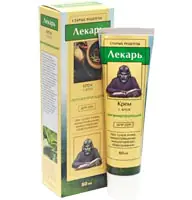 |
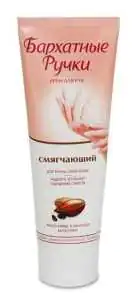 |
 |
 |
|
healing cream based on D-panthenol, vinylin, allatoin, vitamin E and yarrow and calendula extracts. Quickly restores the protective functions of the skin, heals cracks and regenerates the skin. Price about 85 rub.
- Aloe healer
Healing and eliminating dryness cream. Aloe extract restores skin, accelerates regeneration, prevents cracks and softens the skin. 110 rub.
- Velvet handles For very dry skin
Eliminates irritation, dryness and flaking. Ingredients: cocoa butter, D-panthenol, allatoin, glycerin and olive oil. 75 rub.
- Hand restoration cream Belita
Soothes, restores and softens the skin thanks to linden blossom and sea buckthorn extracts, sea buckthorn and wheat germ oil, glycerin, vitamin E. Price about 85 rubles.
- Oil cream from Vitex
Eliminates dryness and flaking. Ingredients: extracts of calendula, chamomile, burdock, apricot kernel oil and Shea butter. 90 rub.
Treatment of cracks
- Ointment made from honey and resin. In a metal saucepan, mix 10 g of oleoresin and honey, add 30 ml of vodka and 15 g of beeswax. Put on fire, stirring constantly until the mixture becomes homogeneous. Cool and refrigerate. The ointment is applied directly to the crack and sealed with a bactericidal plaster for 7-8 hours.
- Calendula ointment. Grind about 100 ml of dried plant flowers into powder and mix with 200 ml of melted pork fat. Bring until smooth in a water bath, cool. It is applied in the same way.
- Plantain ointment. Grind the dry herb into powder and add 9 parts of Vaseline and 3 drops of vegetable oil. It is applied in the same way.
Read more about the treatment of cracked hands in our article.
Dry elbows
Often occurs as a result of mechanical stress (working position with emphasis on the elbows) or infatuation with baths. Dry elbows may be a symptom of:
- hypothyroidism
- iron deficiency anemia
- diabetes mellitus
- autoimmune diseases
- skin diseases.
Traditional medicine recipes:
- Honey-coffee scrub. Add honey to the coffee grounds from a freshly brewed drink, mix and gently massage the resulting scrub onto the steamed skin of your elbows. Rinse with water and lubricate generously with vegetable oil.
- Compress of sunflower oil and sour cream - mix the ingredients in equal parts, soak clean gauze in the mixture, place it on the elbow, wrap it in a warm cloth for 20 minutes.
- Milk bath. Heat fresh milk and dip both elbows in it for 20 minutes.
Wound healing, nourishing and softening creams:
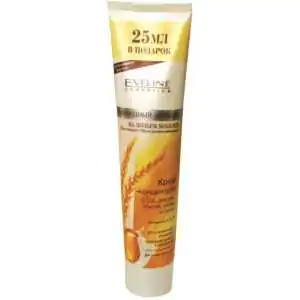
- SOS cream concentrate for very dry skin of hands and elbows from Evelyn - has an intensive effect on rough, dry skin, helps retain moisture in the skin thanks to the active complex: goat milk proteins, wheat germ oil, vitamins A, F, E, H, proelastin . Price about 70 rubles.
- Ointment Radevit – eliminates peeling,
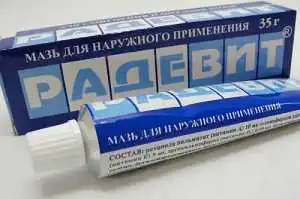
nourishes and softens the skin, actively restores the skin. Contains vitamins D2, A, E, glycerin, petroleum jelly and other components. Price about 370 rub.
Dry facial skin
Very often this feature of facial skin is inherited. Due to the fact that the face is an open part of the body, external factors such as wind, sun, etc., provoke dry skin. Age-related skin changes and improper functioning of the sebaceous glands also aggravate the situation.
A number of pathologies of the gastrointestinal tract, central nervous system and endocrine system have dry facial skin among their symptoms. Hypovitaminosis E and A negatively affects the skin of the face.
General recommendations
- Minimize the harmful effects of environmental factors: wearing wide-brimmed hats in summer, warm wide scarves in winter.
- Use sunscreen from March to September. In winter, use creams from special “winter” series that protect the skin from wind and frost: ZIMA from Faberlic, Winter care from Biocon, Winter from Floresan.
- Wash only with neutral products, avoid bar soap.
- Regularly nourish the skin with creams designed for dry skin.
Traditional medicine recipes
- Fruit and berry mask. Crushed melon, plum and jojoba oil are mixed in equal quantities and applied to the face for a quarter of an hour. Wash off with warm water. Repeat as necessary.
- Egg-oil mask. Mix the beaten yolk of 1 egg with 1 tsp. oil (any vegetable) and carefully add 1 tsp into the mixture. pharmaceutical chamomile extract. Apply the mixture for 15 minutes, then rinse.
- Oatmeal mask. 3 tbsp. Mix oatmeal boiled in milk with 3 tbsp. olive oil, apply a thick layer to the face for 15 minutes. First wash with warm, then cool water.
Nourishing and softening creams
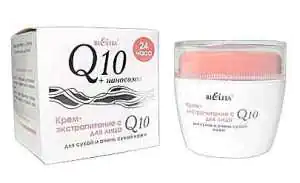 |
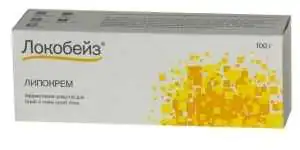 |
 |
|
– provides long-term hydration and nutrition thanks to coenzyme, sesame seed oil, apricot and wheat germ oil, nanosomes and lanolin; restores skin elasticity. Price about 170 rubles.
- LOCOBASE lipocream for dry and very dry skin
cosmetic product with a very high lipid content. Forms a fatty layer on the skin and protects it from drying out, without clogging pores and without the effect of a visible oily sheen. The active composition contains liquid paraffin, macrogol and cetostearyl ether. Price about 650 rub.
- Night cream Clean Line Intense nourishing
contains wheat germ and aloe oil and has an intense softening and nourishing effect. Thanks to aloe, it eliminates irritation and smoothes wrinkles. Price about 65 rubles.
Dry body skin
Severe dryness of the skin of the body is rarely caused by external factors, and is more often a consequence of any disease. Seasonal dryness of body skin is often associated with excessive sun tanning. People who regularly visit baths and saunas are also at risk of dry skin.
General recommendations
- Establish a drinking regime.
- Enrich your diet with dairy products, vegetable oils, fish, and nuts.
- Nourish and moisturize the skin with special creams after taking water procedures.
- Use sunscreen while tanning.
Traditional medicine recipes
- Peeling of sea salt, honey and olive oil – 4 tbsp. take 1 tbsp of honey. remaining ingredients. Lightly massage cleansed skin with the mixture, then take a shower.
- Chamomile and flax seed bath. Boil 5 tsp in 1 liter of water. flaxseed, separately boil 2 tbsp in 1 liter of water. dry chamomile - boil over low heat for 10 minutes. Strain both decoctions and add to the bath, which must be taken for 15 minutes.
- Milk and honey bath. Dissolve 200 grams of honey and 1 tsp in 1 liter of warm milk. oil (olive, almond) - add the mixture to the bath, which is taken for 15 minutes.
- Olive mask. While showering, thoroughly massage your body with heated olive oil, then rinse off the residue with warm water.
Nourishing and softening creams
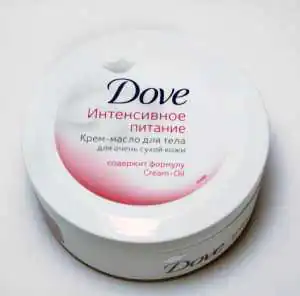 |
 |
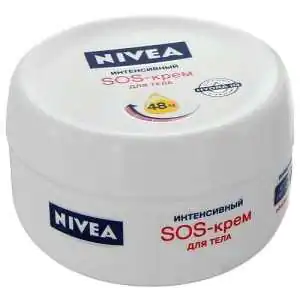 |
|
Provides intense skin hydration thanks to a complex of oils and a special Cream-Oil formula. Price about 250 rubles.
- Johnson's baby oil
Helps retain moisture in the skin, creating a special protective layer on the skin. Hypoallergenic. Price about 130 rubles.
- Nivea SOS-intensive body cream
Regenerating cream with panthenol, grapefruit, lime, camellia, almond oils. Eliminates dryness and tightness while maintaining the effect for 48 hours. Price about 270 rubles.
Dry heels and feet
The problem can be caused by wearing uncomfortable shoes, frequently walking barefoot, or lack of hygienic foot care. Hypovitaminosis, diseases of the endocrine system, fungal infections lead to dry feet. Dry skin on the feet if left untreated leads to the formation of areas of hardening and cracks, which can be complicated by bacterial infection (see treatment of cracked heels).
Usually dry skin (xerosis) does not indicate serious problems, but it can cause discomfort and sometimes lead to unpleasant complications.
Fortunately, most cases of xerosis are caused by external factors that are easy to control.
Separately, ichthyosis is a disease associated with extreme dry skin, which disfigures the patient and causes him physical and emotional suffering. Chronic and severe skin problems are a reason to consult a dermatologist.
Causes of dry skin
The main causes of xerosis include the influence of various environmental factors, as well as diseases that disrupt the functions of the skin.
Possible reasons include:
1. Climatic conditions. The skin becomes dry in winter when the temperature and humidity drop. Winter conditions contribute to the worsening of existing skin problems.
2. Central heating and air conditioning. Fireplaces, central heating, and air conditioners without humidification can cause dry skin.
3. Hot bath or shower. Frequently taking a hot bath, especially if a person likes to splash around in the water for a long time, can destroy the lipid barrier of the skin. It is also not recommended to swim in heavily chlorinated pools.
4. Harsh soaps and shower products. Many popular products contain aggressive surfactants (surfactants). These surfactants simply wash away the protective lipid membrane of the skin, causing dryness.
5. Sun rays. Like heat, the sun's rays dry out the skin. UV rays penetrate the epidermis, affecting the deep layer of skin - the dermis. They destroy collagen and elastin, leading to so-called solar elastosis.
6. Atopic dermatitis. This is one of the most common types of eczema and most often affects dry and sensitive skin.
7. Psoriasis. This skin disease is characterized by the rapid growth of rough, dry, dead skin scales, as well as itchy skin.
8. Diseases of the thyroid gland. Hypothyroidism - insufficient thyroid function - reduces the activity of the sweat and sebaceous glands, which leads to dry skin.
Risk factors for dry skin
Dry skin can develop in any person, but the following groups are most susceptible to xerosis:
1. Elderly people.
2. Residents of countries with dry and cold climates.
3. People who like to take hot showers or baths often.
Symptoms of xerosis
Most often, dry skin is a temporary problem that only bothers you during a certain season, but it can last a lifetime. Symptoms of xerosis depend on your general health, age, where you live, and how much time you spend outdoors.
Possible symptoms include:
1. A feeling of tightness of the skin, especially after a bath.
2. Skin is wrinkled and dehydrated.
3. Skin looks rough instead of smooth.
4. The itching is bothersome, sometimes very intense.
5. Peeling of the skin - from slight to severe.
6. Skin cracks, sometimes bleeding and painful.
7. Redness of the skin, usually in limited areas.
In the following cases, it is recommended to consult a doctor:
1. The condition does not improve despite home measures.
2. Dry skin is accompanied by severe redness.
3. Dryness and itching interfere with normal sleep.
4. Ulcers and infected wounds form due to scratching.
5. The skin peels off in large areas.
Diagnosis of the causes of dry skin
Dry skin can accompany a number of skin and internal diseases, so your doctor will need to run some tests to make an accurate diagnosis. To determine some skin problems, sometimes a careful examination is enough, and to determine, say, thyroid deficiency, you need to analyze the level of thyroid hormones.
A list of skin conditions associated with xerosis includes:
1. Follicular keratosis. This condition causes small, acne-like pimples on the arms, legs and buttocks. Numerous pimples give the skin a rough, sandpaper-like appearance. Pimples are usually flesh-colored, but can also be red and inflamed.
2. Ichthyosis. In this unpleasant disease, skin cells form thick, dry scales that look like fish scales. The scales are small, multifaceted, from white to brown. Ichthyosis can cause deep, painful cracks in the palms and soles of the feet.
3. Xreotic eczema. This disease causes dry skin and numerous cracks in the skin. This characteristic skin appearance is described by some people as “dry riverbed” or “cracked porcelain”. The skin is inflamed, itchy and bleeding.
4. Psoriasis. The disease manifests itself as dry, flaking and itchy skin. The skin in the affected areas is reddish and covered with scales resembling dandruff. In severe cases, the disease may be complicated by infection.
Treatment of dry skin, useful tips
In most cases, dry skin can be treated with simple home remedies such as moisturizing after showering. For peeling skin, your doctor may recommend special creams that contain salicylic acid, lactic acid, or a combination of lactic acid and urea.
For more serious problems, such as atopic dermatitis or psoriasis, ointments and creams containing corticosteroids (Celestoderm B, Elokom, Advantan) can be used. If an infection occurs due to constant scratching or poor hygiene, the doctor may prescribe combination products that also contain antibiotics (Celestoderm B with Garamycin, Triderm).
If you are prone to dryness, it is not always possible to achieve flawless skin.
However, use these tips:
1. Moisturize your skin. There are many products that form a protective film that protects the skin from moisture loss. The simplest and most effective option is baby oil.
2. Limit hot baths and showers. Such procedures should last no more than 15 minutes, and the water should be used warm, not hot.
3. Avoid harsh soaps that dry out your skin. If you have sensitive skin, you cannot skimp on good soaps and shower gels. Use a gentle, oil-infused soap such as Neutrogena or Dove.
4. Use moisturizers immediately after swimming. After your bath, pat your skin gently with a towel to keep your body slightly damp. Immediately afterwards, apply baby oil or another moisturizer to your body.
5. Use a humidifier. If the cause of dry skin is dry air in the house, do not skimp on a humidifier (humidifier), at least a portable one for your room. Maintain your device regularly to prevent the humidifier from becoming a source of bacteria or fungi.
6. Choose appropriate clothing. Natural fibers such as silk and cotton allow your skin to breathe. Avoid fabrics with cheap dyes. When washing, do not use fragrances or other chemicals that may irritate the skin.
For itching and inflammation of the skin, American experts recommend limited use of a cream or ointment containing at least 1% hydrocortisone. This is a medium-strength corticosteroid hormone that copes well with inflammation, itching, and allergic reactions. In the United States, this drug is available without a prescription, but in most countries of the former USSR, hydrocortisone is prescribed by a doctor.
Before using such drugs, it would be a good idea to consult a dermatologist.
Possible complications of xerosis
For some people prone to eczema, dry skin can cause the following complications:
1. Atopic dermatitis.
2. Folliculitis (inflammation of hair follicles).
3. Cellulitis (bacterial infection of the subcutaneous tissue).
These complications usually occur in cases where the skin's protective mechanism is impaired. For example, severe dry skin causes cracks, which open the door to infection.
Dry and itchy body skin are common symptoms that can bother each of us from time to time. Some people have dry skin from birth. In others, a similar symptom occurs under the influence of internal or external factors, it can manifest itself acutely, then subside for a while. In any case, when the skin dries out, a person feels severe discomfort, both physical and moral.
Dehydrated dermis is pale, unhealthy in appearance, prone to redness, peeling and cracking. When in contact with cold, heat, salty or acidic environment, it is easily irritated, begins to itch and turn red. In addition, wrinkles appear on it earlier and are more noticeable.
Both pharmaceutical and folk remedies will help you get rid of unpleasant symptoms. But before you start treating them, it is recommended to consult a doctor to accurately determine the causes.
Why is this happening
The causes and treatment of dryness, itching and sagging body skin are, in fact, two parts of one question that must be solved sequentially. That is, the cause of the discomfort is first established. And depending on it, solutions are selected.
The structure of the skin of every person contains sweat and sebaceous glands. They produce certain substances that, when mixed, form a thin, imperceptible film on the surface of the dermis. But it is of great importance, as it protects against the effects of negative external factors and at the same time does not allow moisture to evaporate.
If for some reason this protective film is regularly destroyed, or the sebaceous and sweat glands do not work properly, the skin begins to suffer. First, they dry out, and then all the unpleasant symptoms accompanying this phenomenon appear: redness, itching, hypersensitivity, peeling and cracks.
So, if xerosis is not congenital, the following factors can provoke its appearance:
- Changes in climatic conditions, including seasonal ones. Insufficiently humidified air in the summer heat or in winter, heated by heating radiators, provokes dehydration of skin cells.
- Abuse of water procedures using hot water and soap are the first and necessary means of hygiene, but if used too often, they destroy the natural protective film; it simply does not have time to form again.
- Neglect of water procedures. In this case, the opposite happens: too many harmful substances accumulate on the skin, which irritate it and interfere with the access of oxygen, moisture and nutrients.
- Hormonal disorders. Hormone levels directly affect the functioning of the sebaceous and sweat glands.
- Metabolic disorders, vitamin deficiencies or hypovitaminosis.
- Poor nutrition. Strict diets, as well as overeating, and even with insufficient consumption of ordinary clean water, seriously harm the condition of the skin.
- Bad habits. Not only alcohol and smoking - excessive consumption of coffee and soda also contributes to dehydration of the body and dermis in the first place.
- Frequent exposure to ultraviolet rays: in the open sun or in a solarium.
- Some dermatological diseases: psoriasis, dermatitis of various etiologies, eczema, keratosis, diabetes mellitus affect the production of ceramides - the building material of skin cells. With a long course of these diseases, the structures of the dermis do not receive the necessary nutrition and do not have time to renew themselves, as a result - xerosis of varying degrees of severity.
- Incorrectly selected and used cosmetics, poor-quality hygiene products. Products containing alcohol and abrasive particles, fragrances and preservatives are especially harmful.
- Taking certain medications, usually antibacterials.
- Stress and overwork.
Practice shows that xerosis is usually caused by a combination of two or more factors. Often, an internal disease (for example, diabetes mellitus or pathologies of the digestive system, when the body does not absorb vitamins, microelements and other nutrients supplied with food) is aggravated by improper care and bad habits. Therefore, you should get rid of this unpleasant phenomenon consistently and comprehensively.
What to buy at the pharmacy
Pharmaceutical products against dry skin can be divided into two broad categories:
- For external use, these are a variety of ointments, creams, gels and lotions, usually without alcohol, based on oils and plant extracts.
- For internal use - as a rule, these are various vitamins for dry skin of the body and face.
They are used for serious problems, when xerosis becomes protracted and ordinary moisturizing creams are no longer enough. Ideally, vitamins and emollient external ointments and lotions will be selected by a dermatologist.
A cream for dry body skin must contain vitamins A, E, C and B. Fatty acids, phospholipids, and ceramides are also welcome in the composition. Must not be:
As for vitamin-mineral complexes, you should pay attention to those that contain the predominant vitamins and fatty acids listed above, as well as zinc and iron. The most affordable and effective supplements are AEVit and Biotin.
How can traditional medicine help?
Many people prefer to fight dryness, itching and sagging body skin with folk remedies. They are more affordable than expensive creams and emulsions, and they are also safer - at least that’s what is commonly believed. Gentle and proven folk recipes will also help remove dry skin on the body and face in a child.
- Baths - for the whole body or its individual parts with the addition of beneficial moisturizing, soothing and softening ingredients. They are done 2-3 times a week, the duration of the procedure is no more than 15 minutes.
- Lotions - they are used for wiping, lubricating, compresses and lotions; depending on the composition, this is done daily or every other day.
- Ointments and masks are applied to the most affected areas. Ointments are usually used every day, and masks are made 1-2 times a week.
Recipes recommended by traditional medicine against xerosis:
- decoction of flaxseed. 5 large spoons of seeds should be poured into a thermos with a liter of boiling water, closed and left for several hours. Then strain. The liquid is used for baths, and the steamed seed can be applied to extremely irritated areas as a compress;
- milk and honey Heat a liter of milk over low heat, pour in 200 g of honey and continue heating until the honey is completely dissolved. But the milk should not boil. Add a spoonful of almond oil to the honey-milk mixture, stir and pour into a bath of warm water;
- oatmeal. 3 tablespoons of ground oatmeal are placed in a bag made of several layers of gauze, tied above the bathtub to a hot water tap so that when opened, water flows through the bag, then immersed in water for a quarter of an hour. You can repeat this procedure every other day;
- almonds and sour cream. Grind one and a half tablespoons of fresh almonds in a coffee grinder and stir with the same amount of fat sour cream. The mixture is applied as a cleansing, moisturizing and softening scrub with gentle massaging movements. After five minutes, wash off in the shower;
- olive oil. The oil is slightly heated, combined with a spoonful of liquid honey and applied to the body for 15 minutes. This mask gently cleanses, removes toxins, nourishes, moisturizes, stimulates regeneration;
- avocado and banana. Both fruits are peeled and pureed. The gruel is diluted with 100 ml of heavy unsweetened cream; if desired, you can also add a couple of drops of wheat germ oil, grape seed or neroli. The mixture is applied for 20 minutes, then washed off with warm water;
- kefir. If the skin is very itchy and red, after the bath you can soak a linen napkin in chilled kefir and apply it as a compress. Cold kefir will soothe, relieve irritation and moisturize it.
Herbs that are useful for xerosis: chamomile, linden, hops, rose petals, jasmine, dill, mint, violet, coltsfoot. Any of these herbs can be mixed in equal proportions, and then prepare an infusion at the rate of one spoon of the mixture for each glass of hot water. The resulting mixture is added to baths or used for compresses and rubbing.
Oils for dry skin: rosehip, rose, almond, coconut, jojoba, wheat germ, shea butter, macadamia, apricot, peach. They are added to bath water, masks, lotions.
Does nutrition play a role?
To quickly eliminate dryness and flaking in both men and women, you should drink as much as possible. And not only in summer, but also in winter, since this is the heating season. This means that you are constantly in a room with hot air, which does not have the best effect on the condition of the epidermis and can cause discomfort.
What else is worth doing:
- eliminate or minimize the consumption of coffee and alcohol;
- make it a habit to consume nuts, seeds and vegetable oils daily;
- stop starvation diets and regularly eat fatty sea fish.
If for some reason you cannot eat fish and dairy products, drink more vegetable and fruit juices with pulp.
Additional tips and tricks
Eliminating dry and itchy body skin during pregnancy is sometimes not so easy. In this case, such a symptom is associated with hormonal changes in the body, so just cream or oil, even the best, will not be enough. Your doctor will tell you what to do and how to deal with itching and dryness throughout the body.
General recommendations, and not only for pregnant women, are:
- drink at least 1.5 liters of clean water daily;
- Do not take hot baths using soap. Preference should be given to a warm shower using a soft cream-gel;
- avoid exposure to direct sunlight;
- temporarily abandon decorative cosmetics and use gentle exfoliating and softening products to cleanse the skin;
- after a shower, do not wipe the body, but pat it dry, and then immediately apply moisturizing oil or lotion;
- wear clothes that are appropriate for the season so as not to freeze, but also not to sweat in them. Preference should be given to natural, breathable fabrics;
- lead a healthy lifestyle, watch your diet, do not abuse alcohol and caffeine;
- avoid stress and overwork, if possible, do not take antibiotics and other potent medications.
Xerosis must be fought from the inside and outside. Reviews from adequate users and doctors recommend sparing no time and money to consult a specialist: in the end, it is cheaper and more effective than looking for ways to combat xerosis experimentally. A simple analysis will show exactly what is missing in the body, and the doctor will tell you what vitamins to take for your problem and how else you can quickly and safely eliminate severe dry skin of the body.



